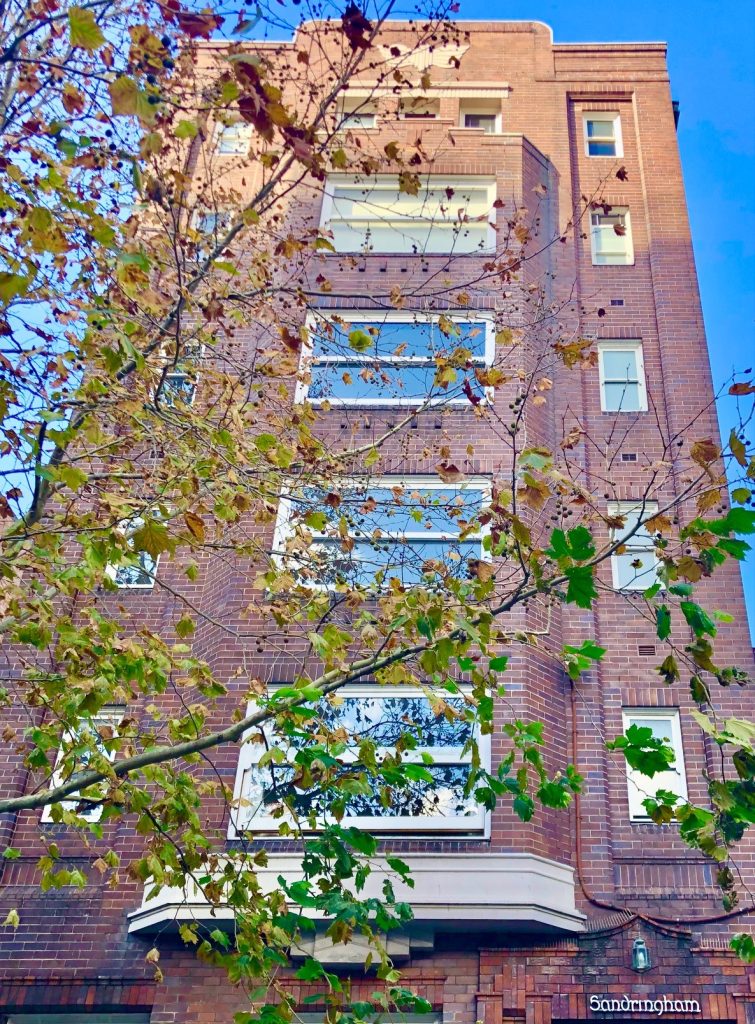SANDRINGHAM

Sandringham apartments, 20 Springfield Avenue Potts Point, is a classic Art Deco apartment block built circa 1935 and designed by Claud Hamilton.
Apartment 39 is for sale through Penny Timothy and Greg McKinley https://www.rwebay.com.au/7467097/
Mr Hamilton was prolific in the Potts Point and Darlinghurst areas and lived locally in Elizabeth Bay.
Claud Hamilton (1891-1943), spelt without an e, architect and inventor of plastic cement, also built one of his other grand buildings, the Savoy, in 1919 at 10 Hardie Street, Darlinghurst.
Hamilton was prolific in the 2011 postcode area and was known in media at the time as a “renowned architect of the day”. He designed 15 apartment blocks that are known. No other architect had such an influence on this area in terms of numbers of apartment blocks.
Hamilton was born in Campbelltown, a small town on the southern tip of the south island of New Zealand. It was renamed Bluff in 1917.
He designed “St John’s Flats” (1916), 241 Darlinghurst Road, “Savoy” (1919), 10 Hardie Street, “Kenilworth” (1920), 18-22 Hardie Street, 235 Victoria Street (1923), “Tennyson House” (1924), 1 Farrell Avenue, “Normandy” (1926), “Regent’s Court” (1929), 18 Springfield Avenue, “Versailles” (1929), 233 Darlinghurst Road, “Springfield Inn” now known as Funk House (early 1930), 23 Darlinghurst Road “Kaloola” (1927), 1 St Neot Avenue, “Byron Hall” (1928), 97 Macleay Street, “Wiringulla” (1927), 2 St Neot Avenue, “Lakemount” (1933), 46 Roslyn Gardens, and “The Tavern” (1940), 76 Elizabeth Bay Road.
He also designed properties in Lithgow, Blue Mountains and “Arawua” (1935), at 6 Palm Beach Road and named after the Arawua Plains, where he was raised.
His King Street offices must have been very busy.
All his buildings reflected the neo-classical and Art Deco styles prolific at the time.
This style evolved from Vitruvius in Roman times and was re-adopted by Palladio in Rennaissance Italy. It was revived in the Georgian period and then again in the 1920s and 30s. It was popular alongside the Art Deco style. Neo-classicism is known for its proportional rooms and windows and ancient Roman and Greek motifs.
Sandringham with its liver coloured brickwork has number of Art Deco and neo-classical features including the winged escutcheon on the parapet of the façade a nod to the Greek God Nike, the winged goddess of victory.
The interior of apartment 39 includes the original cream and green tiled bathroom and fluted pelmets.
In 1927 he ran into financial complications and took legal action and settled the case, successfully for £137/10, owed to recover his costs against a real estate agent, Vincent Morgan, for unpaid work on a proposed block of apartments at Baden Street, Coogee.
But in 1940 Smith’s Weekly reported he owed money to Sydney Council, £50, and had failed to pay. Council petitioned for his bankruptcy in November 1940 and won the case.
He was bankrupt.
Within three years on 22nd May 1943 the Sydney Morning Herald reported he had died aged 52.
It reported that “A Sydney architect, Mr. Claude Hamilton of Elizabeth Bay, died yesterday after a long illness. He was well-known as the inventor of a plastic cement building material and built a large number of houses at Lithgow of this material. Mr Hamilton supervised for Australian Consolidated Industries in a number of its constructions, and designed and constructed a large number of flats at Kings Cross.
He is survived by Mrs. Hamilton, three daughters and a son.”
Mr Hamilton died three years later, aged 53, having left a lasting and distinct architectural legacy.
By
Andrew Woodhouse





